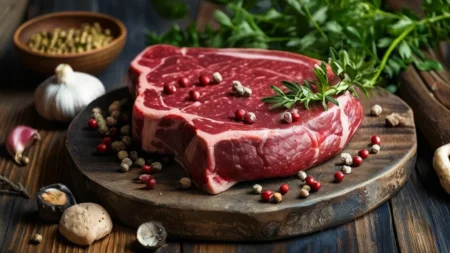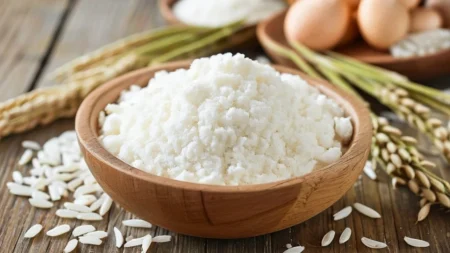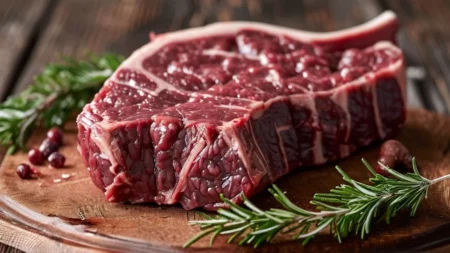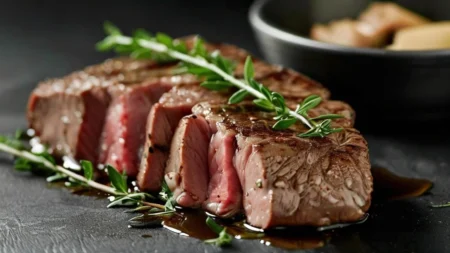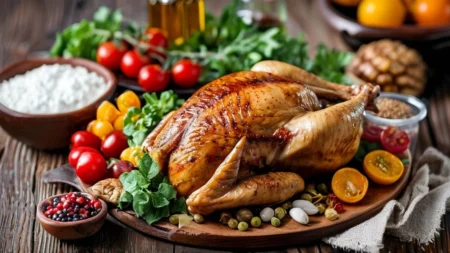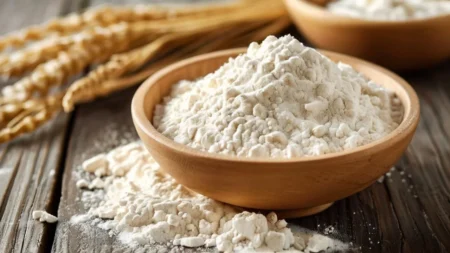Pork Ribs A Flavorful and Nutrient-Dense Cut
Key Takeaways:
- Pork ribs are a popular, flavorful cut of meat, rich in protein and essential vitamins like B12, thiamine, and niacin.
- They are best known for their versatility in cooking methods, from grilling to slow roasting.
- While high in fat, pork ribs can be part of a balanced diet when enjoyed in moderation.
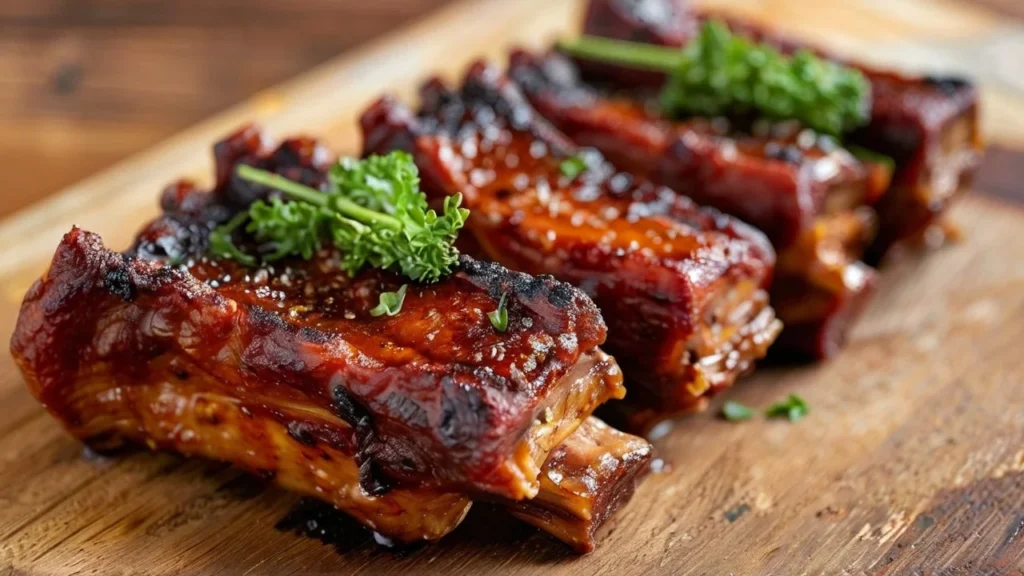
Nutritional Profile of Pork Ribs
Pork ribs, especially when cooked with the bone in, are packed with essential nutrients. Here’s the nutritional breakdown of 100 grams of cooked pork ribs:
| Nutrient | Amount |
|---|---|
| Calories | 320 kcal |
| Protein | 20 grams |
| Total Fat | 25 grams |
| Saturated Fat | 9 grams |
| Carbohydrates | 0 grams |
| Vitamin B12 | 1.5 mcg (60% DV) |
| Thiamine (B1) | 0.8 mg (70% DV) |
| Niacin (B3) | 8 mg (50% DV) |
| Phosphorus | 200 mg (29% DV) |
| Selenium | 40 mcg (73% DV) |
| Zinc | 3 mg (27% DV) |
Rich in Protein
Pork ribs provide a significant source of high-quality protein, necessary for muscle growth, repair, and overall health.
High in B Vitamins
Pork ribs are an excellent source of B vitamins, particularly vitamin B12, thiamine, and niacin, which are essential for maintaining energy levels and supporting brain and nerve health.
Types of Pork Ribs
There are different types of pork ribs, each with distinct characteristics in flavor, fat content, and cooking methods:
| Type of Rib | Description | Best Cooking Methods |
|---|---|---|
| Baby Back Ribs | Cut from the upper part of the ribcage, near the spine. Tender and leaner than spare ribs. | Grilling, smoking, slow-cooking |
| Spare Ribs | Cut from the belly side of the ribcage, larger and fattier. | Smoking, braising, roasting |
| St. Louis Style Ribs | A trimmed version of spare ribs with the cartilage removed, making them more uniform. | Smoking, grilling, slow-cooking |
| Country-Style Ribs | Meaty and cut from the shoulder end, resembling pork chops. | Grilling, roasting, braising |
Baby Back Ribs
Baby back ribs are leaner and smaller than spare ribs, making them a popular choice for grilling and smoking. They tend to cook faster and have a milder flavor.
Spare Ribs
Spare ribs are larger and contain more fat, which results in a richer flavor when cooked low and slow. They are perfect for smoking or braising over a long period.
Health Benefits of Pork Ribs
1. Supports Muscle Growth
Thanks to their high protein content, pork ribs can support muscle growth and recovery. Protein is essential for building lean muscle mass and maintaining bodily functions.
2. Boosts Energy Levels
Pork ribs are a rich source of B vitamins, particularly thiamine and niacin, which help convert carbohydrates into energy. This makes them a valuable source of energy for those with active lifestyles.
3. Rich in Bone-Strengthening Nutrients
Phosphorus and zinc, both present in pork ribs, play crucial roles in bone health. Phosphorus aids in the formation of bones and teeth, while zinc supports immune function and helps with the body’s healing process.
Best Cooking Methods for Pork Ribs
1. Smoking
Smoking is a popular method for cooking pork ribs, particularly spare ribs and St. Louis-style ribs. The slow-cooking process allows the fat to render, resulting in tender, flavorful meat. A dry rub with spices such as paprika, garlic, and brown sugar is commonly applied before smoking to enhance the flavor.
2. Grilling
Grilling baby back ribs over medium heat ensures a nice char on the outside while keeping the meat juicy inside. Basting with barbecue sauce in the final minutes adds a layer of sweetness and tanginess to the ribs.
3. Slow-Cooking
Slow-cooking pork ribs is an excellent method for tenderizing the meat and infusing it with flavors. Spare ribs, in particular, benefit from a long cooking time, allowing the collagen to break down and create melt-in-your-mouth texture.
How to Make Pork Ribs Healthier
While pork ribs are often associated with rich, fatty meals, there are ways to make them a healthier option without sacrificing flavor:
1. Trim Excess Fat
Before cooking, trim any visible fat from the ribs. This will reduce the overall fat content and help prevent greasy dishes.
2. Use a Dry Rub Instead of Barbecue Sauce
Many barbecue sauces are high in sugar, which can add unnecessary calories to your meal. Opt for a dry rub made with spices and herbs for a flavorful, healthier alternative.
3. Opt for Leaner Cuts
While spare ribs are flavorful due to their higher fat content, choosing baby back ribs or country-style ribs can be a leaner alternative.
Popular Side Dishes to Pair with Pork Ribs
Pork ribs pair well with a variety of side dishes, from light salads to rich, hearty sides. Here are some popular options:
| Side Dish | Description |
|---|---|
| Coleslaw | A refreshing, crunchy side made with cabbage and carrots. |
| Cornbread | A slightly sweet, dense bread that complements ribs well. |
| Baked Beans | Rich, sweet, and savory beans slow-cooked in a sauce. |
| Grilled Vegetables | A lighter option, adding balance to the richness of ribs. |
| Potato Salad | Creamy potatoes with mustard or mayo-based dressing. |
Pork Ribs and Nutritional Considerations
High in Fat
Pork ribs, particularly spare ribs, are higher in fat compared to leaner cuts of pork. While this contributes to their rich flavor, it’s essential to enjoy them in moderation as part of a balanced diet.
Sodium Content
Barbecue sauces and marinades often used with pork ribs can be high in sodium. To keep your sodium intake in check, opt for homemade sauces or dry rubs that allow you to control the amount of salt.
Portion Control
Since pork ribs are high in fat and calories, it’s important to be mindful of portion sizes. Pairing ribs with healthy sides like grilled vegetables or a fresh salad can help balance your meal.
Conclusion
Pork ribs are a flavorful, nutrient-dense cut of meat that can be enjoyed in many ways. While they are higher in fat than other cuts of pork, they provide a good source of protein, B vitamins, and minerals like phosphorus and zinc. Whether you prefer baby back ribs, spare ribs, or St. Louis-style ribs, cooking them with care and attention can lead to a delicious, satisfying meal. To make ribs a healthier choice, opt for leaner cuts, trim excess fat, and pair them with lighter side dishes.
FAQ
Q: What’s the difference between baby back ribs and spare ribs?
A: Baby back ribs are smaller, leaner, and come from the upper part of the ribcage, while spare ribs are larger, fattier, and come from the belly side. Both cuts offer distinct textures and flavors.
Q: How can I make pork ribs more tender?
A: To make pork ribs more tender, cook them low and slow using methods like smoking, slow-cooking, or braising. This allows the collagen in the meat to break down, resulting in tender, juicy ribs.
Q: Are pork ribs healthy?
A: Pork ribs can be part of a balanced diet when enjoyed in moderation. Opting for leaner cuts like baby back ribs, trimming excess fat, and pairing them with nutritious sides can make them a healthier option.
Q: How long should I cook pork ribs?
A: Cooking times vary depending on the method, but ribs generally take 2-3 hours when slow-cooked or smoked. Grilling may take less time, especially for baby back ribs.
Q: Can I cook pork ribs in the oven?
A: Yes, pork ribs can be cooked in the oven. Bake them at a low temperature (around 275°F) for 2-3 hours, then finish with a high-heat broil or grill for a crispy outer layer.





